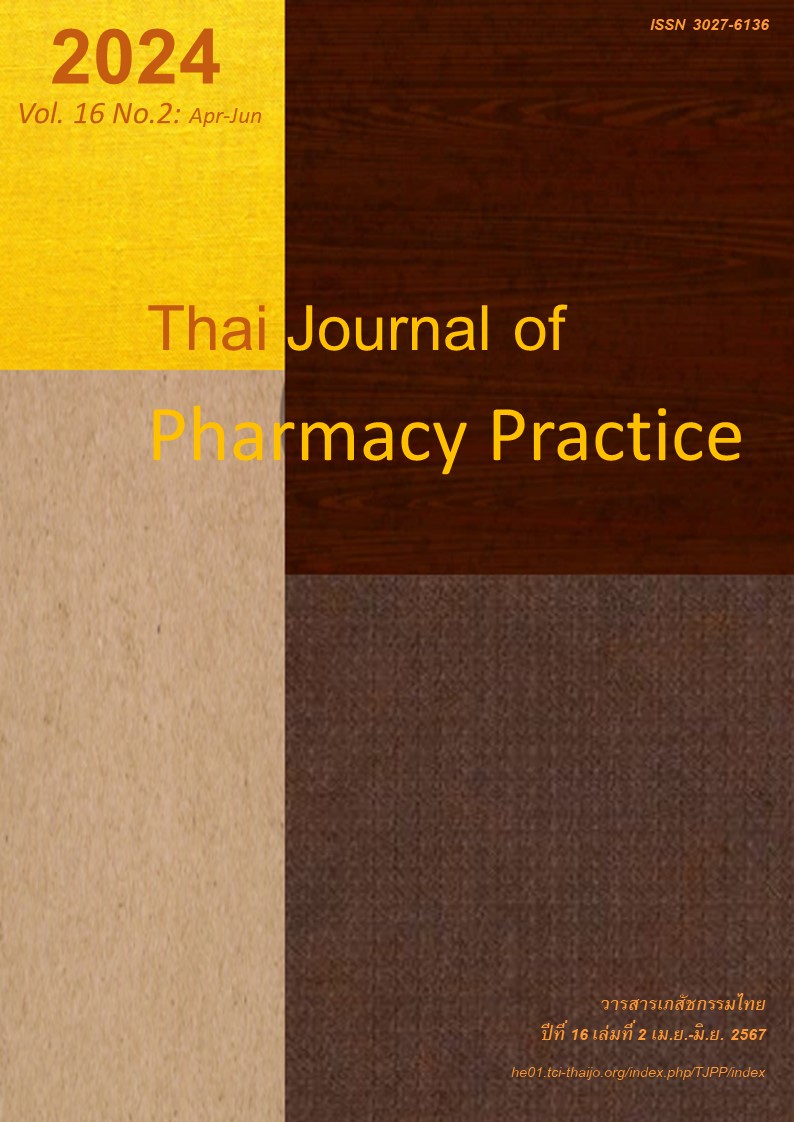การปรับตัวของเภสัชกรต่อการนำหุ่นยนต์ทางเภสัชกรรม มาใช้ในโรงพยาบาลในสังกัดกระทรวงสาธารณสุข
Main Article Content
บทคัดย่อ
วัตถุประสงค์: 1) เพื่อศึกษาการปรับตัวของเภสัชกรโรงพยาบาลต่อการใช้หุ่นยนต์ทางเภสัชกรรม และปัจจัยทำนายการปรับตัว และ 2) เพื่อศึกษาความเชื่อและทัศนคติของเภสัชกรโรงพยาบาลต่อการใช้หุ่นยนต์ในกลุ่มที่ยังไม่มีประสบการณ์ใช้หุ่นยนต์ และปัจจัยทำนายความเชื่อและทัศนคติต่อการใช้หุ่นยนต์ วิธีการ: การศึกษาเชิงวิเคราะห์แบบภาคตัดขวาง ผู้เข้าร่วมการศึกษา คือ เภสัชกรโรงพยาบาลศูนย์หรือโรงพยาบาลทั่วไปในสังกัดกระทรวงสาธารณสุข 115 แห่งที่มีประสบการณ์และไม่มีประสบการณ์ใช้หุ่นยนต์ การเก็บข้อมูลใช้แบบสอบถาม 2 ชุด ให้เลือกตอบตามประสบการณ์ใช้หุ่นยนต์ ประกอบด้วยคำถาม 5 ส่วน ได้แก่ ข้อมูลทั่วไป ประเภทหุ่นยนต์ ทักษะความเข้าใจและใช้เทคโนโลยีดิจิทัล สมรรถนะทางวิชาชีพเภสัชกรรม การปรับตัว และความเชื่อและทัศนคติต่อการใช้หุ่นยนต์ แบบสอบถามพัฒนาจากแนวคิดของRoy ผ่านการตรวจสอบความตรงตามเนื้อหา และทดสอบความเที่ยง แบบสอบถามถูกส่งไปยังโรงพยาบาลศูนย์และโรงพยาบาลทั่วไปทุกแห่งทั่วประเทศ ผลการวิจัย: ผู้ร่วมการวิจัยตอบแบบสอบถาม 283 ราย (อัตราการตอบกลับร้อยละ 49.22) กลุ่มที่มีประสบการณ์ใช้หุ่นยนต์ 59 คน คะแนนเฉลี่ยการปรับตัวอยู่ในระดับปานกลาง (3.61±0.39 จากคะแนนเต็ม 5) ส่วนใหญ่ใช้หุ่นยนต์เครื่องนับเม็ดยา (ร้อยละ 60.3) และใช้ในงานห้องจ่ายยาผู้ป่วยใน (ร้อยละ 55.2) กลุ่มที่ไม่มีประสบการณ์ใช้หุ่นยนต์ 224 คน คะแนนเฉลี่ยเรื่องความเชื่อและทัศนคติต่อการใช้หุ่นยนต์อยู่ในระดับดีมาก (3.72 ± 0.38 จากคะแนนเต็ม 5) ร้อยละ 69.4 คาดว่าจะมีการนำหุ่นยนต์เครื่องนับเม็ดยามาใช้ และร้อยละ 64.2 จะนำหุ่นยนต์ไปใช้ในห้องจ่ายยาผู้ป่วยใน ทักษะความเข้าใจและใช้เทคโนโลยีดิจิทัลสามารถทำนายการปรับตัวของกลุ่มที่มีประสบการณ์ใช้หุ่นยนต์ (b=0.446, P<0.05) และสามารถทำนายความเชื่อและทัศนคติต่อการนำหุ่นยนต์มาใช้ในกลุ่มที่ไม่มีประสบการณ์ใช้หุ่นยนต์ (b=0.235, P<0.05) ได้อย่างมีนัยสำคัญทางสถิติ สรุป: ทักษะความเข้าใจและใช้เทคโนโลยีดิจิทัลสามารถทำนายการปรับตัว ความเชื่อและทัศนคติต่อการใช้หุ่นยนต์ทางเภสัชกรรมของเภสัชกรโรงพยาบาล หากเภสัชกรได้รับการพัฒนาทักษะดังกล่าวอย่างเพียงพอ เภสัชกรจะสามารถปรับตัวได้ดีและมีความพร้อมและสามารถใช้หุ่นยนต์ในการพัฒนางานเภสัชกรรมได้ดี
Article Details

อนุญาตภายใต้เงื่อนไข Creative Commons Attribution-NonCommercial-NoDerivatives 4.0 International License.
ผลการวิจัยและความคิดเห็นที่ปรากฏในบทความถือเป็นความคิดเห็นและอยู่ในความรับผิดชอบของผู้นิพนธ์ มิใช่ความเห็นหรือความรับผิดชอบของกองบรรณาธิการ หรือคณะเภสัชศาสตร์ มหาวิทยาลัยสงขลานครินทร์ ทั้งนี้ไม่รวมความผิดพลาดอันเกิดจากการพิมพ์ บทความที่ได้รับการเผยแพร่โดยวารสารเภสัชกรรมไทยถือเป็นสิทธิ์ของวารสารฯ
เอกสารอ้างอิง
Pruekphakpoom A, Kanitwaranan C, Limkorapaibul S. Digital automation and innovation with a challenge and change in hospital pharmacy frontier [online]. 2019 [cited Aug 25, 2019]. Available from: www.successquality.net/courses/ digital innovation/.
Sng Y, Ong CK, Lai YF. Approaches to outpatient pharmacy automation: A systematic review. Eur J Hosp Pharm. 2019; 26: 157-62. doi: 10.1136/ejhpha rm-2017-001424.
Rodriguez-Gonzalez CG, Herranz-Alonso A, Escude ro-Vilaplana V, Ais-Larisgoitia MA, Iglesias-Peinado I, Sanjurjo-Saez M. Robotic dispensing improves patient safety, inventory management, and staff satisfaction in an outpatient hospital pharmacy. J Eval Clin Pract 2019; 25: 28-35.
Ketkram P, Chanthapasa K. Opinions of pharmacists on benefits of the automated medication pre-dispensing machine. Thai Pharmaceutical and Health Science Journal 2022; 17: 226-334.
Hogan J, Grant G, Kelly F, O'Hare J. Factors influencing acceptance of robotics in hospital pharmacy: a longitudinal study using the Extended Technology Acceptance Model. Int J Pharm Pract. 2020; 28: 483-90.
Keeratisarun E. The study of employee attitude for outpatient pharmacy automation implementation in private hospital [master thesis]. Bangkok: Mahidol University; 2019.
Bouee C. Digital transformation doesn’t have to leave employees behind [online]. 2015 [cited Dec 22, 2022]. Available from: hbr.org/2015/09/digital-trans formation-doesn’t-have-to-leave-employees-behind
Roy C. The Roy adaptation model. 3rd ed. New Jersey: Prentice Hall; 2009.
Lindeman RH, Merenda PF, Gold RZ. Introduction to bivariate and multivariate analysis. Glenview, IL: Scott, Foresman and Company; 1980. p. 163.
Berdie DR, Anderson JF, Niebuhr MA. Question naires: Design and use. 2nd ed. Metuchen NJ: Scarecrow Press; 1986.
Office of the Civil Service Commission. What is digital literacy? [online]. 2019 [cited Nov 4, 2019]. Available from: www.ocsc.go.th/DLProject/mean-dlp.
Trakanchan K. A study of digital learning among employees of PTT Global Public Company Limited [master thesis]. Bangkok: National Institute of Development Administration; 2017.
Paruang S. Development of information and communication technology competency of education students [dissertation]. Bangkok: Chulalongkorn University; 2011.
Pharmaceutical Council. Joint competency of the Bachelor of Pharmacy Program.2019 [cited Nov 4, 2019]. Available from: www.pharmacy.up.ac.th/docu ments/student/Student services_topic_2/4%20Joint Competencies of the Bachelor of Pharmacy Program %20The Pharmacy Council.pdf.
Parinyarux P, Kitikannakorn N. Professional competency for pharmacist in Thailand and other-countries and community pharmacy clerkship in Thailand. Isan Journal of Pharmaceutical Sciences. 2019; 15: 1-13.
James KL, Barlow D, Bithell A, Hiom S, Lord S, Oakley P, et al. The impact of automation on pharmacy staff experience of workplace stressors. Int J Pharm Pract. 2013; 21: 105-16.
Chiaplaem S. The relationships between stress and work adjustment of employees in Kasikorn bank head office [dissertation]. Bangkok: Silpakorn University; 2010.
Novek J. Hospital pharmacy automation: collective mobility or collective control? Soc Sci Med. 2000; 51: 491-503.
Siriwattananurak, P. A Study of the personal charac- teristics, technology acceptance and technology uses for work affecting the effectiveness of private company employees in Bangkok [dissertation]. Bangkok: Bangkok University; 2016.
Niamsub S. An analysis of the cost-effectiveness of outpatient pill counting machines in general hospital contexts [online]. 2018 [cited Nov 4, 2019]. Available from: tmi.or.th/jtmi/wp-content/uploads/2018/12/JTMI -2018-2-5.pdf.4.
de-Carvalho D, Alvim-Borges JL, Toscano CM. Impact assessment of an automated drug-dispensing system in a tertiary hospital. Clinics (Sao Paulo) 2017; 72: 629-36. doi: 10.6061/clinics/2017 (10)07.
Kittipeerachon S. Antecedents of employees’ adapta bility in automotive industry [dissertation]. Chonburi: Burapha University; 2017.
Afolabi MO, Oyebisi T. Pharmacists' perceptions of barriers to automation in selected hospital pharmacies in Nigeria. J Pharm Pract 2007; 20: 64-71.


